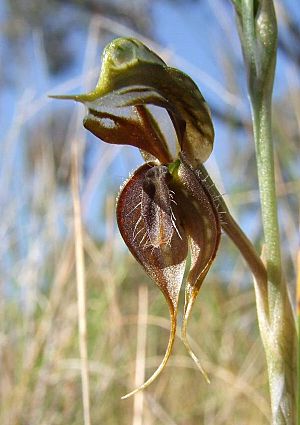Floodplain rustyhood facts for kids
Quick facts for kids Floodplain rustyhood |
|
|---|---|
 |
|
| Pterostylis cheraphila growing near Murtoa | |
| Scientific classification | |
| Genus: |
Pterostylis
|
| Species: |
cheraphila
|
| Synonyms | |
|
Oligochaetochilus cheraphilus (D.L.Jones & M.A.Clem.) D.L.Jones & M.A.Clem. |
|
The floodplain rustyhood (scientific name: Pterostylis cheraphila) is a special type of orchid. It's a plant that belongs to the orchid family. This orchid is found only in a small part of Victoria, Australia. It has a group of leaves that look like a rosette at its bottom. The plant can grow up to seven dark brown or blackish flowers. Each flower has a dark brown part called a labellum, which looks a bit like an insect. You can only find this unique orchid in the Little Desert area.
Contents
What the Floodplain Rustyhood Looks Like
The floodplain rustyhood is a plant that grows from an underground tuber. It's a perennial plant, meaning it lives for more than two years. It's also deciduous, so its leaves fall off at certain times of the year.
At the base of its flowering stem, it has a rosette of about six to twelve leaves. Each leaf is usually about 6 to 22 mm (0.2 to 0.9 inches) long and 3 to 6 mm (0.1 to 0.2 inches) wide.
The plant grows a flowering spike that can be 60 to 250 mm (2.4 to 9.8 inches) tall. On this spike, you can find up to seven dark brown or blackish flowers. These flowers are usually 25 to 32 mm (1.0 to 1.3 inches) long and 10 to 12 mm (0.4 to 0.5 inches) wide. There are also three to five leaves wrapped around the flowering spike.
Flower Parts
The top part of the flower, called the "galea," forms a hood over the central column. This hood is made from the dorsal sepal and the petals. The dorsal sepal has a thin, thread-like tip that is 7 to 11 mm (0.3 to 0.4 inches) long.
The lateral sepals are wider than the galea and have hairy edges. They narrow down to thin, thread-like tips that are 10 to 23 mm (0.4 to 0.9 inches) long. These tips usually grow parallel to each other.
The labellum is a special part of the flower. It's dark brown, thin, and looks like an insect. It's about 6 to 7 mm (0.2 to 0.3 inches) long and 3 mm (0.1 inches) wide. The edges of the labellum are wavy and have short, stiff hairs. There are also two longer hairs near the "head" part of the labellum.
Flowering Time
The floodplain rustyhood usually flowers from October to November.
How it Got its Name
The scientific name Pterostylis cheraphila was first officially described in 1993. This was done by two botanists, David Jones and Mark Clements. They described it from a plant found near Dimboola. Their description was published in a scientific journal called Muelleria.
The second part of the name, cheraphila, comes from ancient Greek words. "Cheras" means "alluvium," "silt," or "detritus," which refers to the type of soil. "Philo" (or philos) means "loving." So, the name cheraphila means "silt-loving," because this orchid likes to grow in silty soil.
Where the Floodplain Rustyhood Lives
The floodplain rustyhood is only found in the Little Desert area and near Murtoa in Victoria, Australia. It grows in silty soils, often alongside ephemeral plants. Ephemeral plants are those that have a very short life cycle, growing and flowering quickly when conditions are right.

